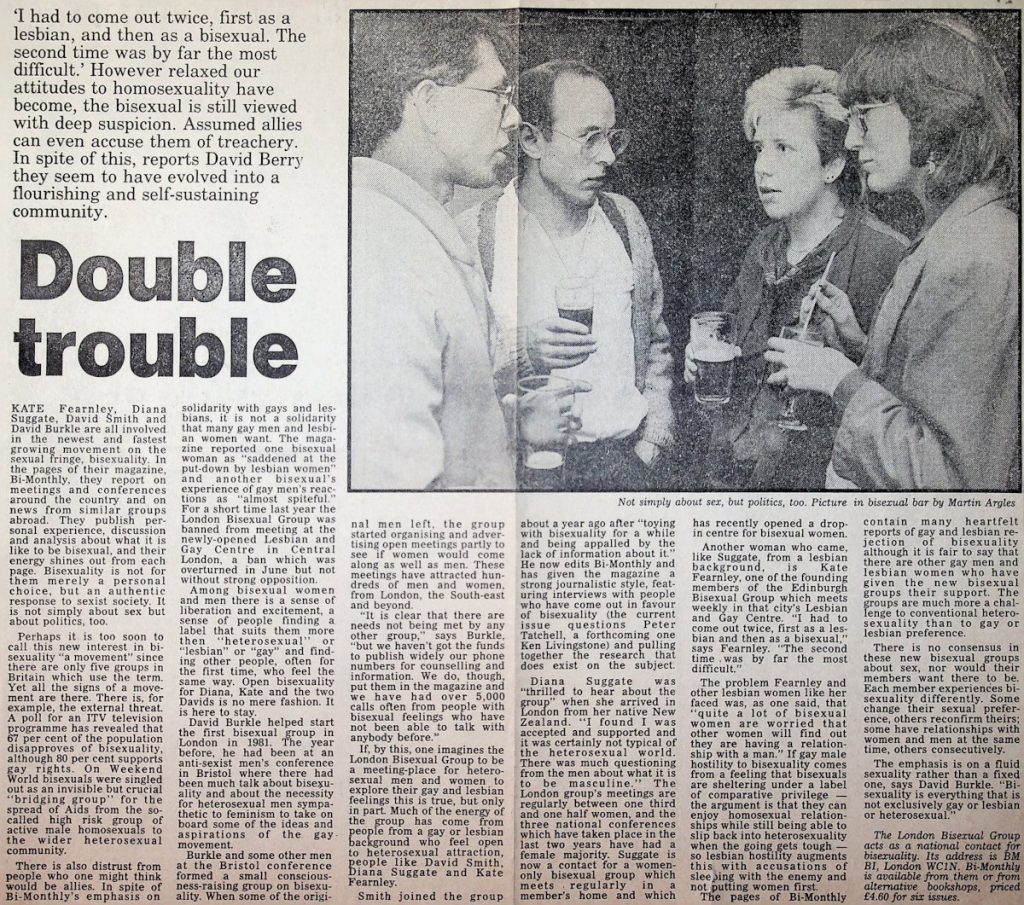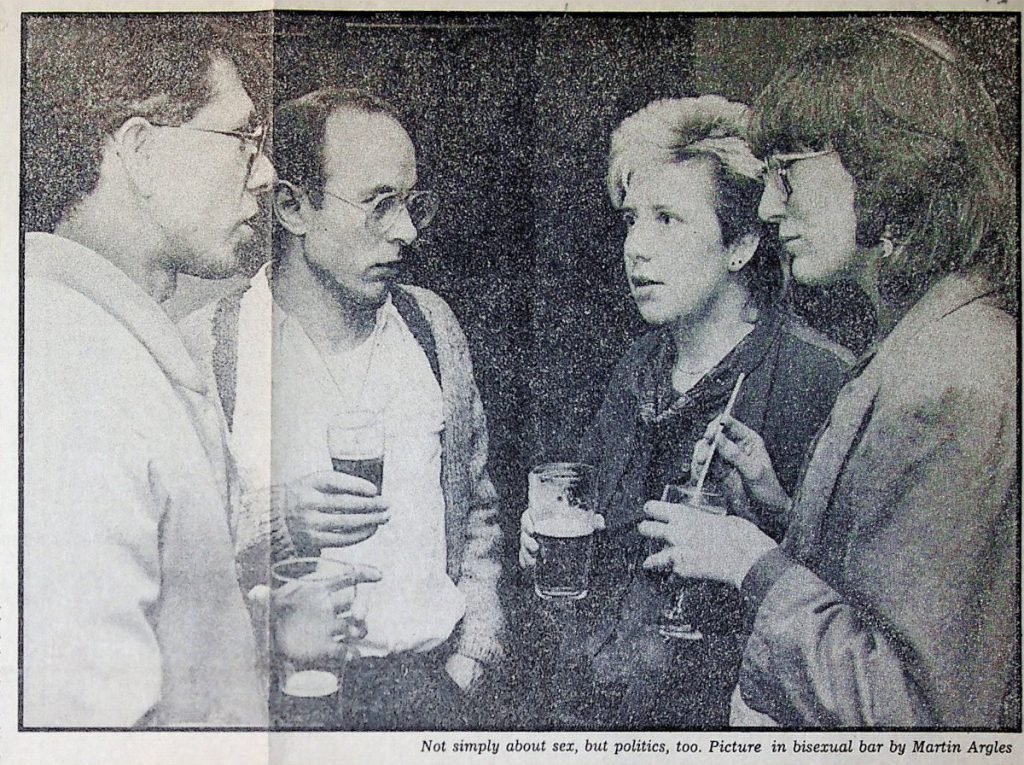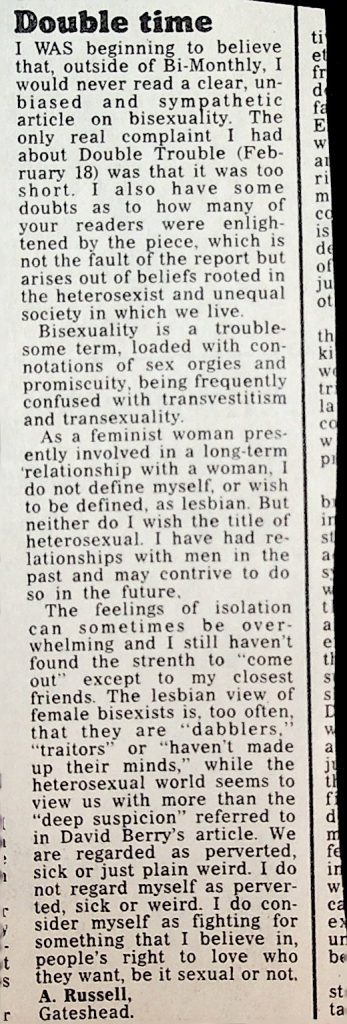Published in the paper's 'Open Space' section, this was my reintroduction to the UK's bi community.
At the end of August 1981, I had just arrived as a new student at Reading University for the start of 'freshers week'. Browsing – rather than buying! – a copy of London listings magazine Time Out something[1]Interestingly, writing in 1986 David Burkle thought he'd used Time Out to publicise the group in the months before it started. But looking for the relevant copy in a library, it turns out that no … Continue reading in the Student Union's shop, I noticed that the first meeting of the London Bisexual Group would be at gay nightclub 'Heaven' on Tuesday, 1st September.
I already knew I was bisexual, thanks to a combination of masturbation fantasies and having been a very willing participant in sex play with more than one gender, so it was an obvious excuse to make the first of many short trips to London: being very close to but not in London was one of the reasons I'd chosen Reading.
Amongst the other things I did that week was join the the SU's 'lighting committee' – the small group that either did the lights for visiting bands at the SU or halls of residence, or connected their lighting system to the somewhat difficult electrical supply on the SU stage.[2]The 60A supply used for this had a.. was it 12mA? 'earth leakage' / 'residual current' trip: if the difference between the current coming out of the box to the band's kit and the current coming back … Continue reading Either way, you not only got into the gigs for free, you got paid as well.
Alas, after that first LBG meeting, there was a clash: both the LBG meetings and the SU's main 'bands' night happened on Tuesday.. and I went for the money and free tickets. Although I often went into London a couple of times a week, it was no longer on a Tuesday.
So while I've met, and often done lighting for, many of the early 1980s groups on their way up (and 1970s groups on their way down) I'd lost touch with the LBG by the time I'd finished in Reading and went back home, not least because they'd stopped meeting at Heaven on a Tuesday.
In February 1986, I was staying for a week at an aunt's house in SW Scotland when this article appeared in the Guardian…
'I had to come out twice, first as a lesbian, and then as a bisexual. The second time was by far the most difficult.' However relaxed our attitudes to homosexuality have become, the bisexual is still viewed with deep suspicion. Assumed allies can even accuse them of treachery. In spite of this, reports David Berry, they seem to have evolved into a flourish and self-sustaining community.
Double Trouble
Kate Fearnley, Diana Suggate, David Smith and David Burkle are all involved in the newest and fastest growing[3]Ghod, I hate that phrase – going from zero to one makes you that. movement on the sexual fringe,[4]! bisexuality. On the pages of their magazine, Bi-Monthly, they report on meetings and conferences around the country and on news from similar groups abroad. They publish personal experience, discussion and analysis about what it is like to be bisexual, and their energy shines out from each page. Bisexuality is not for them merely a personal choice, but an authentic response to sexist society. It is not simply about sex but about politics too.
Perhaps it is too soon to call this new interest in bisexuality "a movement" since there only five groups in Britain which use the term. Yet all the signs of a movement are there. There is, for example, the external threat. A poll for an ITV television station programme has revealed that 67 per cent of the population disapproves of bisexuality, although 80 per cent supports gay rights. On Weekend World[5]ITV's Sunday lunchtime serious current affairs programme. bisexuals were singled out as an invisible but crucial "bridging group" for the spread of Aids[6]Note the Guardian's style guide had already switched from 'AIDS' to 'Aids'. from the so-called high risk group of active male homosexuals to the wider heterosexual community.
There is also distrust from people who one might think would be allies. In spite of Bi-Monthly's emphasis on solidarity with gays and lesbians, it is not a solidarity that any gay men and lesbian women want. The magazine reported on bisexual woman as "saddened at the put-down by lesbian women" and another bisexual's experience of gay men's reaction as "almost spiteful". For a short time last year the London Bisexual Group was banned from meeting at the newly-opened Lesbian and Gay Centre in Central London, a ban which was overturned in June but not without strong opposition.
Among bisexual women and men there is a sense of liberation and excitement, a sense of people finding a label that suits them more than "heterosexual" or "lesbian" or "gay" and finding other people, often for the first time, who feel the same way. Open bisexuality for Diana, Kate and the two Davids is no mere fashion. It is here to stay.
David Burkle helped start the first bisexual group in London in 1981. The year before, he had been at an anti-sexist men's conference in Bristol where there had been much talk about bisexuality and about the necessity for heterosexual men sympathetic to feminism to take on board some of the ideas and aspirations of the gay movement.
Burkle and some other men at the Bristol conference formed a small consciousness-raising group on bisexuality. When some of the original men left, the group started organising and advertising open meetings partly to see if women would come along as well as men. These meetings have attracted hundreds of men and women, from London, the South-east and beyond.
"It is clear that there are needs not being met by any other group," says Burkle, "but we haven't got the funds to publish widely our phone numbers for counselling and information. We do, though, put them in the magazine and we have had over 5,000 calls often from people with bisexual feelings who have not been able to talk with anybody before."
If, by this, one imagines the London Bisexual Group to be a meeting-place for heterosexual men and women to explore their gay and lesbian feelings this is true, but only in part. Much of the energy from the group has come from people from a gay or lesbian background who feel open to heterosexual attraction, people like David Smith, Diana Suggate and Kate Fearnley.
Smith joined the group about a year ago after "toying with bisexuality for a whole and being appalled by the lack of information about it." He now edits Bi-Monthly and has given the magazine a strong journalistic style, featuring interviews with people who have come out in favour of bisexuality (the current issue questions Peter Tatchell, a forthcoming one Ken Livingstone) and pulling together the research that does exist on the subject.
Diana Suggate was "thrilled to hear about the group" when she arrived in London from her native New Zealand. "I found I was accepted and supported and it was certainly not typical of the heterosexual world. There was much questioning from the men about what it is to be masculine." The London group's meetings are regularly between one third and one half women, and the three national conferences which have taken place in the last two years have had a female majority. Suggate is now a contact for a women-only bisexual group which meets regularly in member's (sic) home and which has recently opened a drop-in centre for bisexual women.
Another woman who came, like Suggate, from a lesbian background is Kate Fearnley, one of the founding members of the Edinburgh Bisexual Group, which meets weekly in that city's Lesbian and Gay Centre.[7]Renamed the Lesbian, Gay and Bisexual Centre during BiCon in 1994. "I had to come out twice, first as a lesbian, and then as a bisexual," says Fearnley. "The second time was by far the most difficult."
The problem Fearnley and other lesbian women like her faced was, as one said, that "quite a lot of bisexual women are worried that other women will find out they are having a relationship with a man." If gay male hostility comes from a feeling that bisexuals are sheltering under a label of comparative privilege – the argument is that they can enjoy homosexual relationships while still being able to slip back into heterosexuality when the going gets tough – so lesbian hostility arguments this with accusations of sleeping with the enemy and not putting women first.
The pages of Bi-Monthly contain many heartfelt reports of gay and lesbian rejection of bisexuality although it is fair to say that there are other gay men and lesbian women who have given the new bisexual groups their support. The groups are much more a challenge to conventional heterosexuality than to gay or lesbian preference.
There is no consensus in these new groups about sex, nor would their members want there to be. Each member experiences bisexuality differently. Some change their sexual preference, others reconfirm theirs; some have relationships with women and men at the same time, others consecutively.
The emphasis is on a fluid sexuality rather than a fixed one, says David Burkle. "Bisexuality is everything that is not exclusively gay or lesbian or heterosexual."
The London Bisexual Group acts as a national contract for bisexuality. Its address is BM BI, London WC1N. Bi-Monthly is available from them or from alternative bookshops, priced £4.60 for six issues.
The photo caption is Not simply about sex, but politics, too. Picture in bisexual bar by Martin Argles.
From left to right, the people in the picture are David Smith, David Burkle, Sarah, and Diana Suggate.[8]The next issue of Bi-Monthly said that Kate was in the photo rather than Sarah, but that's definitely not Kate next to David B and Diana. The 'bisexual bar' was almost certainly The Fallen Angel in Islington, by then the venue for the weekly meetings of the London Bisexual Group. Described as 'a friendly mixed brasserie type pub', it was certainly lesbian and gay friendly if not run, and it had an upstairs room that groups could meet in.
The five UK bi groups would have been the mixed London Bisexual Group, the 'open' London Bisexual Women's Group (met at the Drill Hall, a very queer-friendly theatre space now used by RADA), the 'closed' London Bisexual Women's Group (met at members' homes), the Edinburgh Bisexual Group, and the Tyneside Bisexual Group.
A week later, the letters column showed that I wasn't the only person to read the original article:
Double time
I was beginning to believe that, outside of Bi-Monthly, I would never read a clear, unbiased and sympathetic article on bisexuality. The only real complaint that I had about Double Trouble (February 18) was that it was too short. I also have some doubts as to how many of your readers were enlightened by the piece, which is not the fault of the report but arises out of the beliefs rooted in the heterosexist and unequal society in which we live.
Bisexuality is a troublesome term, loaded with connotations of sex orgies and promiscuity, being frequently confused with transvestism and transexuality.
As a feminist woman presently involved in a long-term relationship with a woman, I do not define myself, or wish to be defined, as lesbian. But neither do I wish the title of heterosexual. I have had relationships with men in the past and may contrive to do so in the future.
The feelings of isolation can sometimes be overwhelming and I still haven't found the strength to "come out" except to my closest friends. The lesbian view of female bisexuals is, too often, that they are "dabblers," "traitors" or "haven't made up their minds," while the heterosexual world seems to view us with more than the "deep suspicion" referred to in David Berry's article. We are regarded as perverted, sick or just weird. I do not regard myself as perverted, sick or weird. I do consider myself as fighting for something I believe in, people's right to love who they want, be it sexual or not.
A. Russell
Gateshead
By that point, I'd sent off a letter with a stamped self-addressed envelope and the rest, as they say, is history.
What happened to…?
Kate Fearnley is alive and well. Diana Suggate went back to New Zealand, I think in the late 1980s, and I was told she was still around when I visited there in 2019 but sadly didn't have the time to catch up. I believe that Sarah also went there. David Smith went on to become a long-serving editor of Gay Times and was last seen being jailed for being part of an illegal ticket touting operation his husband ran. David Burkle died a few years ago.
Notes
| ↑1 | Interestingly, writing in 1986 David Burkle thought he'd used Time Out to publicise the group in the months before it started. But looking for the relevant copy in a library, it turns out that no issues of Time Out were published in the four months before mid-September that year, thanks to a strike over the magazine abandoning its 'equal pay for everyone' ethos. Some staff quit to start City Limits and keep those principles, but their first issue was in October. It also turns out that Time Out didn't have a 'lesbian and gay' section until after then either. |
|---|---|
| ↑2 | The 60A supply used for this had a.. was it 12mA? 'earth leakage' / 'residual current' trip: if the difference between the current coming out of the box to the band's kit and the current coming back was less than twelve thousandths of an Amp, the power would automatically be cut off. To give you an idea of how sensitive that was, a standard 13A socket with a circuit breaker – ideal for protecting you in the garden! – will only trip at a 30mA difference. Incoming lighting crews used to blanch when we told them what the sensitivity of this one was. We typically ended up having to bypass it before the show could happen, and this is why the pay was so good: if, say, Boy George was electrocuted on stage, the person who'd bypassed it would be in the way of most of the shit that would hit the fan. |
| ↑3 | Ghod, I hate that phrase – going from zero to one makes you that. |
| ↑4 | ! |
| ↑5 | ITV's Sunday lunchtime serious current affairs programme. |
| ↑6 | Note the Guardian's style guide had already switched from 'AIDS' to 'Aids'. |
| ↑7 | Renamed the Lesbian, Gay and Bisexual Centre during BiCon in 1994. |
| ↑8 | The next issue of Bi-Monthly said that Kate was in the photo rather than Sarah, but that's definitely not Kate next to David B and Diana. |


